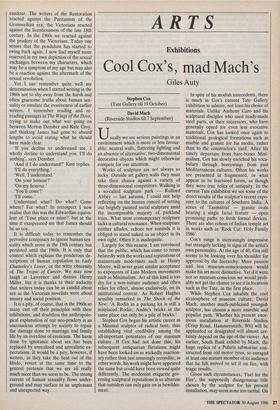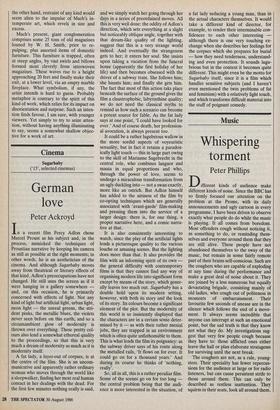ARTS
Exhibitions
Cool Cox's, mad Mach's
Giles Auty
Stephen Cox (Tate Gallery till 19 October) David Mach (Riverside Studios till 7 September) Usually we see serious paintings in an environment which is more or less favour- able: neutral walls, flattering lighting and an absence of alternative, two-dimensional decorative objects which might otherwise compete for our attention. Works of sculpture are not always so lucky. Outside art gallery walls they must take their chance against a variety of three-dimensional competitors. Walking in a so-called sculpture park — Rufford Abbey — last autumn, I could not help reflecting on the human conceit of setting out brightly painted metal sculpture amid the incomparable majesty of parkland trees. What most contemporary sculpture lacks is cultural resonance. When sculpture neither alludes, echoes nor reminds it is obliged to stand naked as an object in its own right. Often it is inadequate.
Largely for this reason, I am convinced that the public, which has come to terms belatedly with the works and reputations of mainstream modernists such as Henry Moore, will never grant similar acceptance to exponents of Late Modern movements such as Minimalism. Art of this kind is too dry for a non-initiate audience and often relies for effect, almost exclusively, on its institutional context. As Robert Hughes sensibly remarked in The Shock of the New: 'A Rodin in a parking lot is still a misplaced Rodin; Andre's bricks in the same place can only be a pile of bricks.'
Stephen Cox began his artistic career as a Minimal sculptor of radical bent, thus establishing vital credibility among the all-important potentates of our museum culture. If Cox had not done this, his subsequent antiquarian flirtations might have been looked on as wickedly reaction- ary rather than just amusingly recondite; in other words, his work might have appeared the same but could have been viewed quite differently. The modernist etiquette gov- erning sculptural reputations is so abstruse that outsiders can only gaze on in bewilder- ment. In spite of his modish antecedents, there is much in Cox's current Tate Gallery exhibition to admire, not least his choice of materials. Unlike Anthony Caro and his sculptural disciples who used ready-made steel parts, or their successors, who have generally opted for even less evocative materials, Cox has looked once again to traditional geological formations such as marble and granite for his media, rather than to the constructor's yard. After his timely departure from bare-bones Mini- malism, Cox has slowly enriched his voca- bulary through borrowings from past Mediterranean cultures. Often his works are presented in fragmented, or what appear to be fractured forms, as though they were true relics of antiquity. In the current Tate exhibition we see some of the direct results of the sculptor's recent expo- sure to the cultures of Southern India. A series of `Tanmatras' — granite ovals bearing a single facial feature — open promising paths to fresh formal devices. There are also echoes of Indian temple art in works such as 'Rock Cut: Holy Family 1986'.
Cox's range is increasingly impressive but strangely lacking in signs of the artist's own personality. At the age of 40, Cox still seems to be looking over his shoulder for approval by the hierarchy. More passion and less museum-consciousness would make his art more distinctive. Yet if it were not so museum-conscious we would prob- ably not get the chance to see it in locations such as the Tate, in the first place.
While Stephen Cox inhabits the cool stratosphere of museum culture, David Mach, another much-publicised youngish sculptor, has chosen a more anarchic and populist path. Whether his present enor- mous installation at Riverside Studios (Crisp Road, Hammersmith, W6) will be applauded or denigrated will almost cer- tainly depend on the age of the viewer. An earlier, South Bank exhibit by Mach, the huge replica of a Polaris submarine con- structed from old motor tyres, so enraged at least one mature member of its audience that he felt moved to set it on fire, with tragic results.
Given such circumstances, 'Fuel for the Fire', the supposedly disingenuous title chosen by the sculptor for his present installation, may seem none too tactful. On the other hand, restraint of any kind would seem alien to the impulse of Mach's in- temperate art, which revels in size and excess.
Mach's present, giant conglomeration comprises some 25 tons of old magazines loaned by W. H. Smith, prior to re- pulping, plus assorted items of domestic furniture. This furniture is trapped, often at steep angles, by vast swirls and billows formed most cleverly from interwoven magazines. These waves rise to a height approaching 20 feet and finally make their exit, at a lower level, via an empty marble fireplace. What symbolism, if any, the artist intends is hard to guess. Probably metaphor is contrary to the spirit of this kind of work, which relies for its impact on disorientation and surprise. Such an inten- tion finds favour, I am sure, with younger viewers. Yet simply to try to seize atten- tion, without having anything illuminating to say, seems a somewhat shallow objec- tive for a work of art.









































 Previous page
Previous page